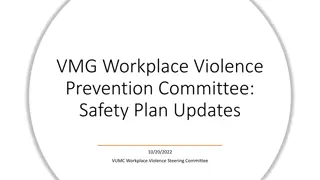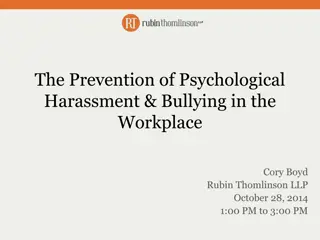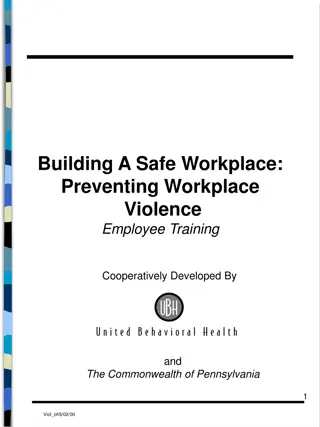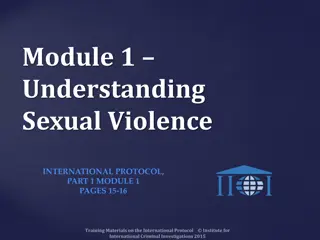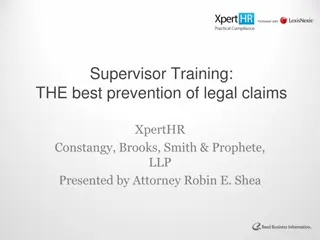Workplace Violence Prevention Reference Manual for Supervisors
This reference manual provides supervisors with comprehensive information on preventing workplace violence in a cooperative effort with the Commonwealth of Pennsylvania. It covers awareness, preparedness, intervention, reporting incidents, documentation, threat assessment, trauma effects on employees, and more. The manual emphasizes the importance of supervisor roles, follow-up actions, and providing a safe work environment. Various resources and guidelines are included to help supervisors effectively manage and prevent workplace violence incidents.
Download Presentation

Please find below an Image/Link to download the presentation.
The content on the website is provided AS IS for your information and personal use only. It may not be sold, licensed, or shared on other websites without obtaining consent from the author.If you encounter any issues during the download, it is possible that the publisher has removed the file from their server.
You are allowed to download the files provided on this website for personal or commercial use, subject to the condition that they are used lawfully. All files are the property of their respective owners.
The content on the website is provided AS IS for your information and personal use only. It may not be sold, licensed, or shared on other websites without obtaining consent from the author.
E N D
Presentation Transcript
Building A Safe Workplace: Preventing Workplace Violence Reference Manual for Supervisors Cooperatively Developed By and The Commonwealth of Pennsylvania
Building A Safe Workplace: Preventing Workplace Violence Reference Manual for Supervisors Contents I. Introduction II. Awareness III. Preparedness IV. Intervention A. Self B. Program Objectives A. The Supervisor s Role B. Ensuring a Safe Place to Work A. Building Employee Awareness B. Tips for Dealing with Domestic Violence C. Behaviors to Watch For A. A SEAP Reminder B. Do s and Don ts for Supervisors V. The Importance of Follow-up A. Reporting Incidents B. Documentation Checklist C. Role of the Workplace Violence Coordinator/ Team 1. Taking Action 2. Threat Assessment D. Threat of Violence Flow Chart E. Threat of Violence Summary Steps Checklist F. How Trauma Affects Employees G. Critical Incident Stress Debriefing(CISD) VI. Closing SupervisorViol_handoutandtrainer 2, 5/5/00
Building A Safe Workplace: Preventing Workplace Violence Reference Manual for Supervisors Appendix A. Important Phone Numbers B. Commonwealth of Pennsylvania Management Directive 205.33 C. Reporting Data Sheet for Incidents of Workplace Violence D. Definitions E. Statistics, Facts, and Costs F. Critical Incident Stress Information 1. Common Symptoms After a Critical Incident 2. Things to Remember About Trauma 3. What You can Do for Others 4. What You Can Do for Yourself G. Exercises H. Certificate of Completion Template SupervisorViol_handoutandtrainer 3, 5/5/00
Program Objectives 1. Participants will understand the the specific role of supervisory and management personnel in maintaining a safe place to work. 2. Participants will be able to identify action steps relating to a report of actual or potential violence. 3. Participants will be able to identify resources available following an incident of workplace violence. 4. Participants will understand the impact of violence on employees and the workplace. SupervisorViol_handoutandtrainer 4, 5/5/00
Ensuring A Safe Place to Work: Prevention Every Commonwealth supervisor is responsible for observing and reporting any workplace situation which may contribute to the occurrence of violence. Develop, communicate, and enforce agency policies and procedures. Identify and address potentially violent or difficult situations. Report and respond to job performance concerns as they arise. Involve employees in identification and resolution of potentially violent situations. Provide management/ employee development through training. Manage organizational change. Provide performance evaluations and on-going feedback. Evaluate new hire and exit interview process. Take appropriate safety and security precautions. Ensure a free flow of information and communication. Provide information regarding SEAP, wellness, mental health and chemical dependency benefit. SupervisorViol_handoutandtrainer 5, 5/5/00
Building Employee Awareness 1. Be aware of changes and how they occur in people. 2. Be understanding of personal situations. 3. Pay attention to behavior. 4. Be truthful. 5. Know where to go for help. SupervisorViol_handoutandtrainer 7, 5/5/00
Tips for Dealing with Domestic Violence Let the employee know what you have observed. Express concern. Make a statement of support. Offer a SEAP referral. Discuss confidentiality. SupervisorViol_handoutandtrainer 8, 5/5/00
Behaviors to Watch For Common indicators of workplace problems: attendance problems/issues Issues requiring excessive amounts of supervisor/manager s time Decreased productivity and efficiency Inconsistent work patterns Poor on-the-job relationships Inability to concentrate Safety concerns Poor health and hygiene Unusual or change in behavior Fascination with guns or other weapons Evidence of possible drug or alcohol abuse Evidence of serious stress in the employee s personal life Continual excuses/blaming others Unshakable depression NOTE: The above indicators may be associated with issues other than workplace violence. Any behavior impacting workplace productivity and safety must not be ignored. SupervisorViol_handoutandtrainer 9, 5/5/00
A Reminder Observed behaviors may be indicative of potential workplace violence or require interventions including a SEAP referral. Be sure to report and follow-up on your observations. SupervisorViol_handoutandtrainer 11, 5/5/00
Ensuring A Safe Place to Work Every Commonwealth employee is responsible to help ensure workplace safety. As such, employees are to report any workplace situation which may contribute to the occurrence of violence to their supervisor in accordance with agency policy. Supervisors are to take appropriate action and report back to the employee in a timely manner. Inappropriate use of the reporting system is subject to disciplinary action. Any report made in good faith will be accepted. SupervisorViol_handoutandtrainer 12, 5/5/00
Dos and Donts for Supervisors Consider these general reminders when discussing problematic behavior with an identified employee. Don t... try to diagnose the problem. discuss drinking unless it occurs on the job. moralize. Restrict criticism to job performance or attendance. be misled by sympathy evoking tactics. cover up for a friend. put the person in the basement to file reports. ignore the problem or the signs. Do point out that SEAP is available, confidential, and can help. make it clear that the Commonwealth is concerned only with job performance. explain that the employee must decide for him or her self whether or not to seek assistance. remember that chemical dependence is a progressive disease. remember that as a supervisor, it is your responsibility to respond to any threat or actual act of violence. SupervisorViol_handoutandtrainer 13, 5/5/00
The Importance of Reporting Incidents Use the Reporting Data Sheet for Incidents of Workplace Violence to report all occurrences of workplace violence as soon as possible following an incident. The Workplace Violence Coordinator will review and evaluate this information in its efforts to maintain workplace safety. The following are some of the basic elements to be included in each report: Where available, reports may be submitted electronically. All other locations shall be forwarded/faxed to the Information Systems Support Division in the Office of Administration at (717) 783-4429. Location of incident Circumstances Name of victim Name of perpetrator Type of incident Description of injuries Who responded Description of incident Contributing causes Inappropriate use of this reporting form is subject to disciplinary action. Any report made in good faith will be accepted. SupervisorViol_handoutandtrainer 14, 5/5/00
Documentation Checklist Documentation should include specifics to describe a particular incident or an employee s inappropriate behavior. When preparing your documentation, it may be helpful to review the following checklist to ensure completeness and accuracy. Select elements which apply. ___Did you record the documentation promptly, while your memory was still fresh? ___Have you indicated the date, time, and location of the incident(s) documented? ___Did you record the action taken or the behavior exhibited? ___Did you indicate the person(s) or work products involved? ___Have you listed the specific performance standards violated or exceeded? ___Did you record the consequences of the action or behavior on the employee s total work performance and/or operation of the work unit? ___Have you been objective, recording observations and not impressions? ___Did you indicate your response to the action of the employee s behavior? ___Did you indicate the employee s reaction to your efforts to modify his/her behavior? SupervisorViol_handoutandtrainer 15, 5/5/00
Workplace Violence Coordinator/ Response Team Purpose: 1. Assess the vulnerability to workplace violence. 2. Reach agreement on preventive actions to be taken. 3. Implement plans for responding to acts of violence. 4. Recommend/ implement related training programs. 5. Implement plans for responding to acts of violence Establish telephone teams. Develop an emergency evacuation plan Establish a second source of communication Assign personnel to assist in calming witnesses Increase security measures Keep employees informed Suggested Team Membership: Senior Site Manager Human Resource Personnel Legal Counsel Security/ Safety Professional Psychologist SEAP Professional Medical/ Health Professional Law Enforcement Union and/ or Employee Representative SupervisorViol_handoutandtrainer 16, 5/5/00
Taking Action As a part of their function the Workplace Violence Coordinator will activate pre-designed plans and procedures for: Getting help Communication issues Legal issues Media interaction (Coordinated through Agency Central Press Office) Maintaining safety & order SupervisorViol_handoutandtrainer 17, 5/5/00
Responding to a Threat: Threat Assessment In responding to a threat, the Workplace Violence Coordinator will: 1.Confirm the incident. 2. Make an immediate investigation. 3. Call and advise law enforcement/ security as appropriate. 4. Activate the Threat Assessment Team (where available). 5. Develop a plan. 6. Conduct investigations and interviews. 7. Coordinate internal and external communication. 8. Coordinate with SEAP to provide CISD services (in consultation with the Office of Administration) and SEAP counseling a s appropriate. 9. Determine special care needs to be taken so the situation is not escalated. 10. Determine duty to warn and inform target as appropriate. 11. Debrief. SupervisorViol_handoutandtrainer 18, 5/5/00
Threat of Violence Flow Chart Incident occurs Notify Personnel Treat as emergency. Notify security, then Personnel, management Violence Coordinator(VC) and/or Supervisor assess whether life threatening NO YES Gather facts Contact appropriate functions- security, violence coordinator, management, SEAP,others on a need to know basis YES Expand assessment team to include legal, Medical, others, as needed Assess whether reasonable validity is established to continue the investigation. Develop initial action plan(e.g, determine security matters, duty to warn , plan for confrontation of employee, suspension issues, medical evaluation needs NO Bring to closure Conduct more thorough investigations; interview witnesses, co-workers Assessment team to review all of the facts and develop a long term action plan addressing disciplinary action, security needs, management changes, return to work plan, prevention issues, etc. Remember: Clarify confidentiality and anonymity boundaries early Document everything in writing Debrief SupervisorViol_handoutandtrainer 19, 5/5/00
Threat of Violence: Summary of Steps ___ Threat occurs ___ Report threat to, supervisor, manager, violence coordinator, SEAP ___ Notify managers ( need to know basis only) ___ Establish confidentiality ___ Determine who will be involved in investigation of incident ___ Gather facts; speak with witnesses, co-workers ___ Plan investigation ___ Establish immediate action plan (need for additional security, co-workers immediate issues, duty to warn) ___ Involvement of other resources (legal, medical, SEAP, public relations, external resources) ___ Review facts of case as a team ___ Confrontation of employee (present facts; give employee an opportunity to deny, explain; bring response back to team) ___ Notification of other employees (advise of SEAP role, employee debriefings, support groups) ___ Decision on employee suspension ___ Decision on need for medical evaluation (this may help with the risk assessment;provide understanding of what happened from employee s point of view) ___ Review all the facts as a team ___ Long term action plan(decisions regarding return to work, termination, other, disciplinary action) ___ Debriefing of team (review case, documentation, further work place needs identified in this process; restore morale, etc.) SupervisorViol_handoutandtrainer 20, 5/5/00
How Trauma Affects Employees Following traumatic situations individuals experience normal reactions to an abnormal event. Crisis reactions demonstrated by employees who are victims and/or observers of violent incidents generally fall into several stages: Stage One: Emotional Reaction Stage Behaviors are typical of a fight or flight stress reaction and include disbelief, denial, tearfulness. Physical symptoms may include racing of the heart, hyper-vigilance; disturbances of eating, sleeping, and concentration. Stage Two: Impact Stage Emotions intensify and may include rage, anger, grief, depression, guilt, withdrawal. Physical symptoms may also intensify. Stage Three: Reconciliation Stage Individual has had an opportunity for self-evaluation of the incident , begins the process of reintegration, resolution and closure. SupervisorViol_handoutandtrainer 21, 5/5/00
Critical Incident Stress Debriefing Definition Structured informal discussion that provides education, validation, reassurance and support for participants reactions to a critical incident while allowing an opportunity to ventilate. Debriefings are not counseling, treatment or psychotherapy. Purpose and goals To facilitate recovery from traumatic stress and reduce or prevent post traumatic stress disorder, depression, anxiety or panic reaction, phobias, or other mental health concerns. Process Introduction Facts Thoughts Reactions Symptoms Teaching Re-entry NOTE: Requests for a CISD must be made by the SEAP Coordinator and coordinated with the Office of Administration- SEAP. SupervisorViol_handoutandtrainer 22, 5/5/00
Training Evaluation for: Preventing Workplace Violence Trainer s Name: ________________________ Date/Time: ________________ Bureau/Agency: ________________________ Location: __________________ Please circle your responses and make comments or suggestions below. Excellent 1. What is your OVERALL opinion of this course? 2. The course MATERIALS were: 3. The course ACTIVITIES were: 4. The instructor s PRESENTATION of the information was: 5. The instructor s KNOWLEDGE of the the subject was: 6. Would you recommend this training to co-workers? Very Good Little Value Good Poor 5 5 5 4 4 4 3 3 3 2 2 2 1 1 1 5 4 3 2 1 5 4 3 2 1 YES NO What did you feel was the most useful? What did you feel was the least useful? What changes would you recommend to improve this training? Comments, questions and concerns: SupervisorViol_handoutandtrainer 23, 5/5/00
Appendix SupervisorViol_handoutandtrainer 24, 5/5/00
Important Phone Numbers SEAP REFERRAL LINE ..1-800-692-7459 SEAP CONSULTATION LINE .1-800-662-9206 OA-SEAP .(717) 787-8575 NAME/TELEPHONE NUMBER OF AGENCY/FIELD SEAP COORDINATOR__________________ NAME/TELEPHONE NUMBER OF AGENCY/FIELD WORKPLACE VIOLENCE COORDINATOR ________________________ TELEPHONE NUMBER OF LOCAL LAW ENFORCEMENT_____________________________ SupervisorViol_handoutandtrainer 25, 5/5/00
Definitions Workplace: A workplace is any Commonwealth owned or leased property, location where Commonwealth business is conducted, or site where an employee is considered on duty. Commonwealth vehicles being utilized for Commonwealth business are included in this definition. Additionally, work- place violence can occur at any location if the violence has resulted from an act or decision made during the course of conducting Commonwealth business.* Violence: Violence connected to the workplace takes many forms. Incidents of workplace violence include, but are not limited to threats in person, by letter or note, telephone, fax, or electronic mail; intimidation, harassment to include sexual harassment, mugging, robbery,and attempted robbery, and destruction of Commonwealth property. Cases that are considered extremely serious include, but are not limited to, physical assault, rape,or murder, and bomb threats. Incidents may take place between employees;l employees and clients; employees and acquaintances/ partners; and employees and strangers. Incidents of workplace violence may occur either at or away from the workplace. The determining factors in assessing whether an incident constitutes workplace violence are the individuals involved and the relationship of the action to the workplace; the location of the incident; and/or if the violence is a result of Commonwealth business.* Assault: To attack someone physically or verbally, causing bodily or emotional injury, pain and/or distress. This might involve the use of a weapon, and includes actions such as hitting, punching, pushing, poking, and kicking.** Domestic violence: A reference to acts of physical and psychological violence, including harassing or intimidating behavior, that occur as a part of a personal relationship such as marriage or other intimate relationships. Included in the concept of domestic violence are spousal abuse, abuse among intimates, as well as physical and sexual abuse of children and/or the elderly or the infirmed.** SupervisorViol_handoutandtrainer 26, 5/5/00
Definitions (continued) Intimidating or harassing behavior: Threats or other conduct which in any way creates a hostile environment, impairs operations, or frightens or inhibits others. Psychological intimidation or harassment includes making statements which are false, malicious, disparaging, derogatory, rude, disrespectful, abusive, obnoxious, insubordinate, or which have the intent to hurt others reputations. Physical intimidation or harassment may include holding, impeding, or blocking movement, following , stalking, touching or any other inappropriate physical contact or advances.** Threat: Any oral or written expression or gesture that could be interpreted by a reasonable person as conveying an intent to cause physical harm to persons or property. Statements such as, I ll get him or She won t get away with this are examples of threatening expressions.** State Employee Assistance Program(SEAP): A program for state employees designed to assist employees and families with substance abuse, emotional, family, financial, marital, and/or personal problems. All employees, supervisors, managers and union stewards are encouraged to utilize the services of SEAP when personal problems first develop regardless of any job performance concerns. Policy and procedures are contained in Executive Order 1996-10, Management Directive 505.22 and Manual M505.3, all titled State Employee Assistance Program.* *Management Directive 205.33, Workplace Violence, 6/22/99 **US Department of Health and Human Services, HHS Guidelines: Understanding and Responding to Violence in the Workplace , 11/96. SupervisorViol_handoutandtrainer 27, 5/5/00
Commonwealth of Pennsylvania As of January,1999, statistics from Agencies in the Commonwealth of Pennsylvania provide some limited data for review. 12. Fire/Arson (2) 13. Murder (1) Of the 272 reported incidents of workplace violence, occurrences of various forms of violence are 1. Face to Face Personal Threats (43) 2. Physical Assault (41) 3. Robbery(32) Vandalism(32) 4. Disorderly Conduct (27) 5. Personal Threat by Telephone(26) 6. Theft (16) 7. Verbal Abuse (14) 8. Other (10) 9. Personal Threat by a Third Person (8) Personal Threat by Letter/Memo (8) 10. Bomb Threat by Phone(7) 11. On Worksite Without Authorization(5) Types of incidents of workplace violence were: Work Related 152 (55.8%) Random 62 (22.8%) Personal 29 (10.7%) Domestic 13 (4.8%) Other 16 (5.8%) NOTE: These statistics should only be considered as probable indicators of types of violence across all Commonwealth Agencies and are not provided as conclusive data. SupervisorViol_handoutandtrainer 28, 5/5/00
The Facts According to the National Institute for Occupational Health and Safety (NIOSH), the following factors may increase a workers risk of homicide: Working alone or in small numbers. Working alone at night or in the early morning hours. Working in high crime areas. Guarding valuable property or possessions. Working in community settings. Exchange of money with the public. Both men and women who work in government have a greater number and higher rate of assaults than private sector employees. The annual rate of nonfatal assaults against women working in state government is 8.6 times higher than women in the private sector; women working in local government are 5.5 times as likely to be assaulted than private sector women. Bachman, Ronet. National Crime Victimization Survey: Violence and Theft in the Workplace. Washington, DC: Bureau of Justice Statistics, US Department of Justice, July, 1994. SupervisorViol_handoutandtrainer 29, 5/5/00
Related Costs Costs for workplace violence are incurred in the following ways: Security Building repair and cleanup Business interruptions with customers Lost productivity Lost work time Turnover Salary continuation for those who are injured or traumatized Increased workers compensation claims Increased medical claims Increased absenteeism Increased insurance premiums Increased number of lawsuits Effects on health, family life, and stress levels SupervisorViol_handoutandtrainer 30, 5/5/00
Common Symptoms After a Critical Incident After experiencing a traumatic event, it is very common, in fact quite normal, for people to experience a wide range of emotional or physical reactions. These responses may appear immediately after the event or some time later. They may last for a few days, a few weeks, or even longer. Don t worry -- these are normal reactions to an abnormalsituation. It s important to understand that like the flu, your reactions will run their course and you will feel better in time. The following are some of the most common symptoms: Emotional ~ Fear ~ Anxiety ~ Depression, sadness, grief ~ Feeling hopeless or helpless ~ Feeling numb ~ Irritability ~ Inappropriate emotional responses ~ Anger ~ Guilt, survivor guilt, survival guilt ~ Phobias ~ Denial ~ Excessive worry about others ~ Agitation ~ Feeling overwhelmed Behavioral ~ Social withdrawal/Silence ~ Hyperalert to environment, hypervigilance ~ Suspiciousness ~ Emotional outbursts, loss of control ~ Changes from typical behavior ~ Avoiding thoughts, feelings or situations related to the event ~ Changes in communication ~ Change in sexual function ~ Increased consumption or alcohol and/or other drugs Physical ~ Nausea/Diarrhea ~ Shallow breathing ~ Twitches/Tremors ~ Dizziness/Faintness ~ Chills/Sweating ~ Easily startled/Jittery ~ Fatigue ~ Changes in appetite ~ Sleep disturbances and nightmares ~ Headaches ~ Grinding teeth ~ Feeling uncoordinated Cognitive Thoughts ~ Confusion ~ Difficult concentrating and making decisions ~ Memory problems ~ Shortened attention span ~ Overly critical ~ Preoccupation with the event ~ Flashbacks ~ Overly sensitive SupervisorViol_handoutandtrainer 31, 5/5/00
Things to Remember About Trauma Everyone responds differently to trauma. Try not to judge yourself or others. This is an important time to honor your own feelings and experiences as well as those of others. Experiencing a critical incident may trigger memories of other trauma you have experienced. This is normal and although painful, will pass in time. Take care of yourself. It is important to rest, eat well, and exercise to relieve pent-up feelings and stress. Put unrelated stressful decisions on hold. Don t force yourself to do things that feel uncomfortable. Allow for time alone and with others as you need it. A trauma in the workplace is serious. We may not realize how much a part of our lives our co-workers have become until something happens to one of them. While we may question the appropriateness of grieving at work, it is necessary in order to put closure on the incident. People grieve in different ways and those differences need to be supported and respected. It can be helpful to consider the possible positive results that can come from experiencing a trauma or loss. The experience can lead to a reassessment of what s really important, an opportunity to make changes, and to be more appreciative of those around us. For many people, surviving a crisis can help build self-confidence. Knowing they had the strength to manage through a very difficult situation can lead to believing: If I made it through that I can make it through anything! SupervisorViol_handoutandtrainer 32, 5/5/00
What You Can Do for Others Take care of yourself first. Then you can help others. Listening Listen carefully. Acknowledge feelings as normal. Be sensitive to individual circumstances, and different points of view. Don t respond with you re lucky it wasn t worse. Instead, say that you are sorry such an event has occurred and you want to understand and help. Don t take emotional responses like anger personally. Respect an individual s need for privacy. If someone doesn t want to talk about the incident or their feelings, don t insist. Reaching Out At Work Organize support groups at work to help one another Offer a listening ear to someone who hasn t asked for help but may need it. Give encouragement, support and understanding with on-the-job issues. Identify resources for additional help (SEAP, mental health benefit, human resources department). Helping Family and Friends Offer to spend time with the traumatized person. Reassure them that they are safe now. Offer help with everyday tasks like cleaning, cooking, caring for the family. Respect their need for privacy and time alone. Suggest available help (SEAP, community resources, church groups, etc.) Keep communication open - be available and accessible. SupervisorViol_handoutandtrainer 33, 5/5/00
What You Can Do For Yourself When you ve experienced a trauma, it can be a shock to your whole system. The following are some ideas to help you cope with any physical or emotional symptoms you may be experiencing: Eat well-balanced and regular meals, even if you don t feel like it. Good nutrition is very important when you are feeling stressed. Get plenty of rest. Exercise regularly. It can help work off some physical stress symptoms, leaving you feeling calmer and better able to relax. If you re feeling lethargic, exercise can help energize you and clear your mind. Avoid caffeine, especially if you are having trouble sleeping. Avoid the use of drugs or alcohol, including prescription and over-the-counter drugs to numb the pain. It will only complicate or delay your recovery. Structure your time and set priorities. Maintain your basic normal routine, but give yourself permission to skip the extras for a while. Don t make any major life changes or decisions. Do make as many small daily decisions as possible to reassert your sense of control. Don t try to avoid or deny reoccurring thoughts or feelings about the incident. They are normal and will decrease over time. Give yourself permission to feel rotten and to share your feelings with others. Do things that you enjoy. Take mini-breaks: go out to dinner, take 10 minutes alone, watch a movie. Talk with people you trust: your family, friends, co-workers. Don t be afraid to reach out. People do care. Don t be afraid to set limits with others when you don t feel like talking. You don t have to discuss the incident or your feelings when you don t want to. Don t label yourself as crazy. Remind yourself you re having normal reactions. Write down your thoughts and feelings. This can be especially helpful if you re having trouble sleeping or when you wake from a troubling dream. Ask for help if you need it. If you are having trouble coping on your own help is available from many sources: Professional assistance from a counselor may sometimes be necessary. This does not imply weakness or craziness. It simply indicates that the particular event was just too powerful to handle by yourself. In the workplace you may be able to get assistance from your co-workers, the human resource department, or SEAP. Church, friends, family, and other community resources can be valuable sources of support. SupervisorViol_handoutandtrainer 34, 5/5/00
Exercise: What Should Sally Do ? Case Study 1 Over the past few weeks, Sally, a receptionist,who is known for her friendliness, has become unusually quiet. She has had a warm but strictly platonic relationship with Nate, a receiving clerk, for the last 8 months. He drops by her desk frequently to chat. Although they did not know each other prior to meeting on the job, both are from the same small town some distance away and have some common memories and experiences. Sally has confided in Nate about some unrest in her marriage to Bill. Bill does not want Sally to work because he fears she will meet some one more successful than he. Sally related to Nate that when she and Bill go out, he always comments about people giving her the eye or trying to pick her up. Bill claims that Sally purposely flirts to make him angry and jealous. He was so upset the last time this happened that he slammed his fist on the car hood and dented it. He calls her at work at least twice a day and sends her flowers as an apology every time they have a blow-up. He shows up unannounced at Sally s work from time to time to take her to lunch, but Sally feels like he is just checking up on her. When Nate asked Sally about her quieter demeanor she brushed him off and said she was too busy to talk. He wanted to ask her about the bandage she had supporting her wrist, but Sally told him she didn t have time. What can Sally do? What can Nate do? SupervisorViol_handoutandtrainer 35, 5/5/00
Exercise: What Should You Do ? Case Study 2 Henry is your co-worker. Over the last few years he has become increasingly argumentative. He can never seem to agree with anyone about anything. He has gotten moody and his moods can change suddenly from silence to depression to temper tantrums. He constantly complains about money, and has mentioned that he would like to get a divorce. You cannot predict how he will react to the normal stresses at work. SupervisorViol_handoutandtrainer 36, 5/5/00
Exercise: What Should Elise Do ? Case Study 3* By all appearances, Tom was a model employee. And knowing how hard it is these days to find employees, much less good ones, Elise felt lucky to find him. So she didn t speak up as she should have when Tom got too demanding too soon. Instead, she told her colleagues about this much needed enthusiasm and commitment to work. First, he wanted to change his hours. Instead of pointing out the problems this would create, Elise went out of her way to make it work. Then he just had to have his own computer. She justified this request by saying that he needed to catch up with the team. Even after he yelled at a co- worker and a client, Elise simply noted that he had picked on the worst performer and the most difficult client. Elise needed an employee who could energize the department and she wanted Tom to succeed quickly. Then it got personal. Tom invited himself to Elise s house one Saturday. It was his week to take the kids and he wanted Elise to meet them. Tom and the kids arrived in an old, battered van. That afternoon he asked Elise if she would be their godmother. She agreed to because she felt sorry for the kids. By the time Tom left that day, he also had talked her into letting him use the company truck to get to and from work. So the phone call this morning didn t surprise Elise. Tom and co- worker Brian had been at it again, only this time, Tom threw Brian against the wall and punched him repeatedly. Security called the police and Brian was taken to the hospital. The police were holding Tom in custody. As she drove to work, Elise admitted to herself: Her silence didn t really come from helpfulness or compassion. It came from fear. *EAP Digest, January/February, 1998, p.19. SupervisorViol_handoutandtrainer 37, 5/5/00
Exercise: What Should Joe Do ? Case Study 4 Joe works second shift in the warehouse. One day, at shift start-up, Joe, who was assigned to the Receiving Area with 3 other employees, noticed a regular vendor s truck as it raced toward the dock and came to a screeching halt. Joe wondered if something was wrong and was about to greet the usual driver when he noticed someone new on the job. Joe approached the truck and was about to introduce himself. Before any of that could happen, a man sprung from the truck cab. Using profanity and speaking in a very loud voice, he asked why no one was there to assist him. He also hollered that if he didn t get some help fast he would dump his whole load and didn t really care that it might break. The profanity continued. Now he was right in Joe s face. You guys were called and told I d be here and be in a hurry. Now you re all waltzing around like you have nothing to do. I m not going to do it for you. This isn t my job. That jerk who drives this truck is at the hospital with his wife. If it was my wife I d let her suffer. That s what they all deserve. So I was told if I didn t help I could just find something else to do for good. That boss knows I can t get another job so easily. Not after what happened with my last one. It s guys like you who always get me in trouble, complaining that you ve been picked on. Well, if you wimps would act like you re alive maybe you wouldn t turn me into such a bully. I d just as soon use this crow bar on you as I would these crates, so what ll it be? SupervisorViol_handoutandtrainer 38, 5/5/00
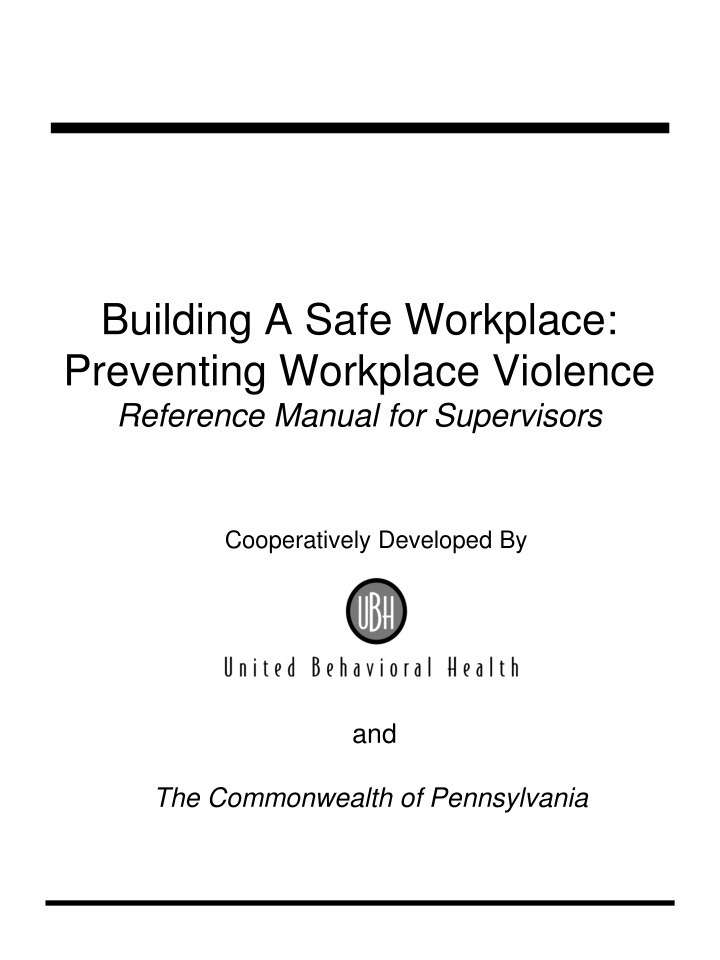



![Workplace Violence Prevention Plan in [District]: Definitions, Elements, and Implementation](/thumb/117038/workplace-violence-prevention-plan-in-district-definitions-elements-and-implementation.jpg)
